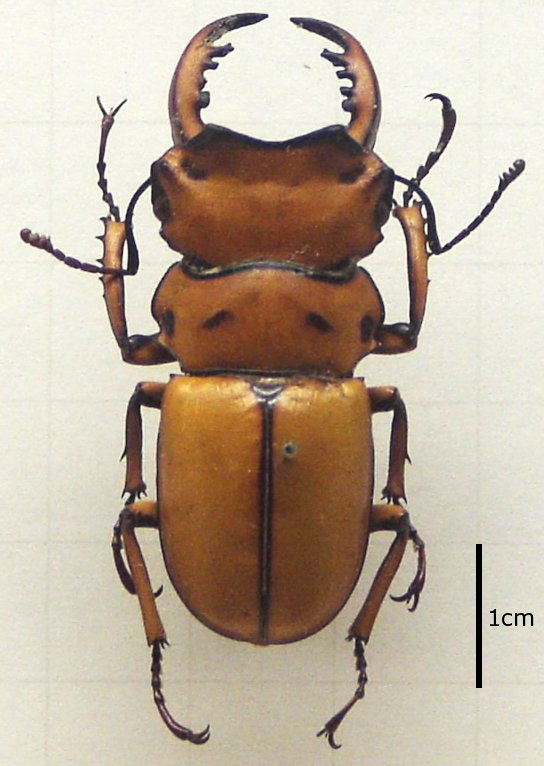|
Neolucanus Castanopterus
''Neolucanus castanopterus'' is a beetle Beetles are insects that form the order Coleoptera (), in the superorder Endopterygota. Their front pair of wings are hardened into wing-cases, elytra, distinguishing them from most other insects. The Coleoptera, with about 400,000 describ ... of the family Lucanidae.It is found in south and southeast Asia, including India and Thailand. References Lucaninae Beetles described in 1831 {{Lucanidae-stub ... [...More Info...] [...Related Items...] OR: [Wikipedia] [Google] [Baidu] |
Beetle
Beetles are insects that form the order Coleoptera (), in the superorder Endopterygota. Their front pair of wings are hardened into wing-cases, elytra, distinguishing them from most other insects. The Coleoptera, with about 400,000 described species, is the largest of all orders, constituting almost 40% of described insects and 25% of all known animal life-forms; new species are discovered frequently, with estimates suggesting that there are between 0.9 and 2.1 million total species. Found in almost every habitat except the sea and the polar regions, they interact with their ecosystems in several ways: beetles often feed on plants and fungi, break down animal and plant debris, and eat other invertebrates. Some species are serious agricultural pests, such as the Colorado potato beetle, while others such as Coccinellidae (ladybirds or ladybugs) eat aphids, scale insects, thrips, and other plant-sucking insects that damage crops. Beetles typically have a particularly hard e ... [...More Info...] [...Related Items...] OR: [Wikipedia] [Google] [Baidu] |
Lucanidae
Stag beetles are a family of about 1,200 species of beetles in the family Lucanidae, currently classified in four subfamilies.Smith, A.B.T. (2006). A review of the family-group names for the superfamily Scarabaeoidea (Coleoptera) with corrections to nomenclature and a current classification. The Coleopterists Bulletin 60:144–204. Some species grow to over , but most to about . Overview The English name is derived from the large and distinctive mandibles found on the males of most species, which resemble the antlers of stags. A well-known species in much of Europe is ''Lucanus cervus'', referred to in some European countries (including the United Kingdom) as ''the'' stag beetle; it is the largest terrestrial insect in Europe. Pliny the Elder noted that Nigidius called the beetle ''lucanus'' after the Italian region of Lucania where they were used as amulets. The scientific name of ''Lucanus cervus'' adds ''cervus'', deer. Male stag beetles are known for their oversize mandi ... [...More Info...] [...Related Items...] OR: [Wikipedia] [Google] [Baidu] |
Lucaninae
The Lucaninae comprise the largest subfamily of the stag beetles (Lucanidae). Characteristics include partial to complete division of the eyes by a canthus, geniculate antennae, and distinctly separated coxae. The body is typically elongated and slightly flattened. Genera Some notable species are also listed: * '' Aegognathus'' * '' Aegus'' * '' Agnus'' * '' Allotopus'' * '' Amneidus'' * '' Andinolucanus'' * '' Aphanognathus'' * '' Apterocyclus'' * '' Apterodorcus'' Arrow, 1943 * '' Auxicerus'' * '' Bartolozziolucanus'' * '' Beneshius'' * '' Bomansius'' * '' Brasilucanus'' * '' Cacostomus'' ** '' C. squamosus'' * '' Calcodes'' * '' Cantharolethrus'' ** '' C. luxeri'' * '' Capreolucanus'' * ''Cardanus'' * '' Casignetus'' * '' Charagmophorus'' * '' Chewlucanus'' * '' Chiasognathus'' * '' Cladophyllus'' * '' Cladognathus'' * '' Colophon'' * '' Cyclommatus'' ** '' C. scutellaris'' * '' Dendezia'' * '' Diasomoides'' * '' Dinonigidius'' * '' Dorculus'' * '' Dorcus'' * '' Dynod ... [...More Info...] [...Related Items...] OR: [Wikipedia] [Google] [Baidu] |


